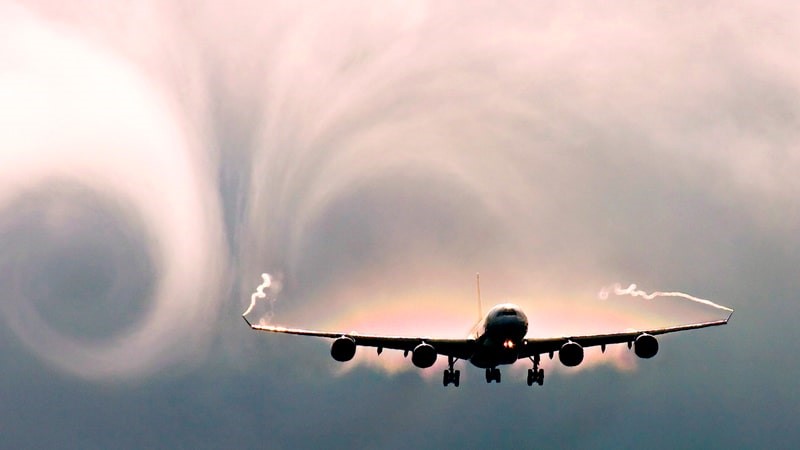Although generally not visible, in the presence of water vapor or smoke turbulence can appear in the form of eddies. They are often called ‘waves of the sky’.
When an airplane passes through a zone of turbulence, the general feeling is that of passing through a bumpy road. Turbulence can sometimes include changes in the G force (force of gravity) that manifest themselves with a sensation of heaviness or lightness – depending on whether it is positive or negative “G” – as well as a more or less smooth wave motion.
In itself, the turbulence does not represent a threat, not even for the plane, for the passengers. You can check the resistance of an airplane wing here. Airplanes are designed to withstand turbulence much more severe than the greater ones to which they will be subjected throughout their useful life. Additionally, aircraft today are equipped with technology such as weather radars that allow pilots to detect and estimate the magnitude of most turbulence.
What is a turbulence?
The particles that make up the atmosphere tend to move in a laminar fashion in overlapping layers with different densities and temperatures without mixing. Turbulence occurs when this stable motion is disturbed by higher temperature updrafts, by the presence of obstacles such as mountains, or even by the passing of an airplane. Different weather situations can cause turbulence.
In a past article we explained the main most dangerous meteorological phenomena for an airplane.
We can find different types of turbulence:
- Clouds of vertical development. Upstream or downstream currents
- Turbulence in Clear Air (TAC). It is one of the most fearsome turbulence situations, as they are not associated with a cloudy front and are very difficult to predict. They can be associated with the Jet Stream, a very strong current of wind, which originates in the upper layers of the troposphere and even in the lower layer of the stratosphere and extends over several thousand kilometers.
- Wind shear or shear. It is not a question of turbulence itself, but it is a sudden or very abrupt variation in the intensity and direction of the wind. Wind shear is usually associated with situations of atmospheric instability, and is especially dangerous in the final phases of approach and landing.
- Generated by other aircraft. They are produced by the wingtips and consist of cyclonic turbulent vortices – in the presence of steam or clouds, they become visible – that can reach very high speeds, up to 90 knots / hour (almost 170 km / hour). In approach phases they pose a risk to the plane flying behind, although, given that they tend to “fall” towards the ground, it is enough to keep a path slightly above to avoid them.
Classification of turbulence
Turbulence can be classified according to its magnitude. Therefore they will be:
- Light turbulence. Passengers will notice small jolts, but onboard service can occur as normal.
- Moderate turbulence. The intensity of the shaking is increasing, and the warning to fasten the seat belts comes on. However, in general, onboard service can continue.
- Severe turbulence. In this situation, the occupants of the aircraft, whether they are passengers or flight attendants, run the risk of hitting the walls or ceiling of the aircraft, so they will remain seated and with their seat belts fastened.
To avoid any risk, before starting the flight, the METAR and TAFOR meteorological forecasts are consulted and the significant maps are consulted to find the best route.
What do pilots do when there is turbulence?
Pilots are the first to know that a turbulent zone is going to be crossed, either by indications from the ground control or by warnings from other aircraft or by consulting the weather forecasts as mentioned above. This phenomenon is more a problem of comfort than of security, which can nevertheless generate concern in the passage.
When the pilot detects turbulence, the steps he follows are:
- Notify passengers. The seatbelt adjustment lights come on, so that passengers remain in their seats. The toilets on board are closed. In addition, depending on the severity of the turbulent area to be traversed, it is notified by public address and / or the service on board is suspended.
- Talk to air traffic control. The route control that is currently monitoring the flight is requested to change the flight level (altitude) to a more stable higher or lower level. Normally, if the requested level is free, the operation is usually authorized.
- Establish communication with other aircraft. If other aircraft are proceeding on the same airway in the opposite direction, communication can be established, both to gather information and to prevent the presence of a turbulent area.
Normally, commercial routes try to avoid turbulent areas as much as possible, because of what they represent in terms of loss of comfort for passengers – fear of turbulence is one of the main causes of aerophobia, or fear of flying-, but we have to be very clear that they do not pose the least risk to the aircraft. After all, the plane (and not us) is who in the air is in its natural environment.
